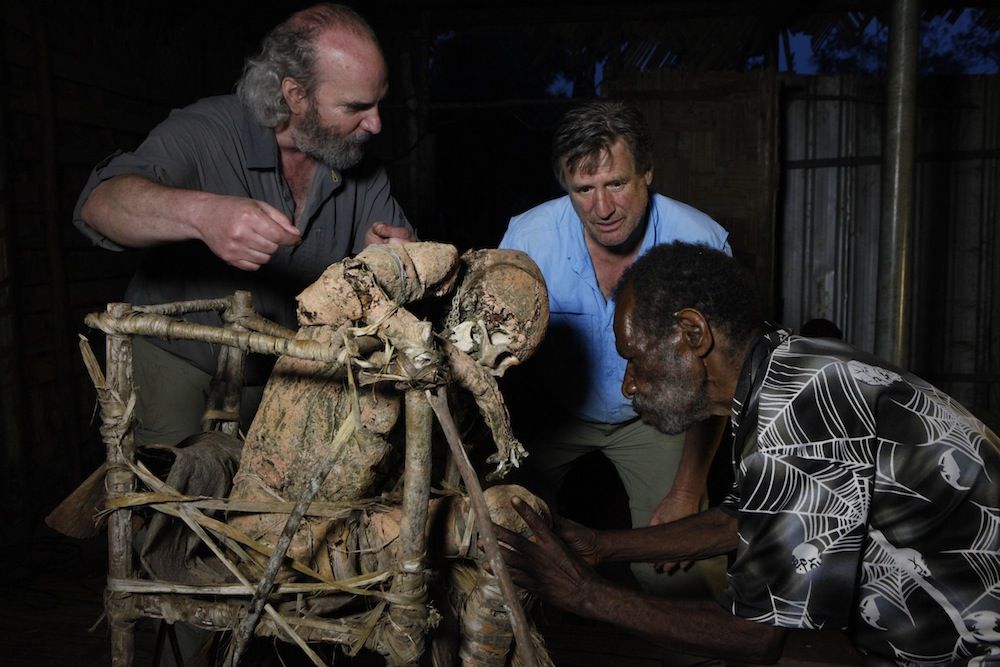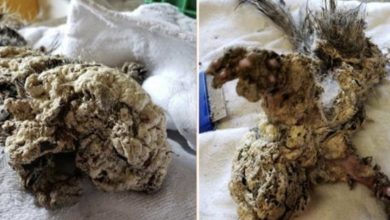The Smoked Mummies of Papua New Guinea

In 2008, researchers from North America traveled halfway around the world to help restore the mummy of a village chief in Papua New Guinea. The chief, a shaman and warrior named Moimango, had been mummified with smoke in the 1950s. Because the team wanted the local villagers to be able to maintain the body after they left, they worked with local jungle materials. (Photo credit: Reproduced with permission from The Anatomical Record 298(6), June 2015: Special Issue The Anatomy of the Mummy)

Moimango had been mummified after his death in the 1950s. He, along with other mummified members of the Anga clan, were perched high up on a cliff overlooking their village of Koke in Papua New Guinea. After decades, the bodies were not in great shape, with Moimango’s head in danger of falling off.

Anthropologist Ronald Beckett of Quinnipiac University in Connecticut first heard that the villagers were hoping to restore the mummy from his friend and colleague, photojournalist Ulla Lohmann, who had visted the group several times. Koke is in a fairly remote region of Papua New Guinea, an arduous muddy car ride and tough hike from the nearest transport hub. It is also distant from both the more globalized port cities of the coast and the mining settlements of the highlands. Here, Beckett walks on the path to Yeakunga on the way to Koke village.
Cliffside view

Here, a view of Koke village as seen from the cliffs above. The climate is warm and humid, which would ordinarily cause a body to decay quite rapidly. But the smoked mummification process prevents body decomposition.
Mummy maintenance

The researchers were hoping to use restoration materials that the villagers could access after they left. So when they arrived in 2008, they asked the Anga to give them a tour of the jungle to find suitable materials. Here, Andrew Nelson (left), a researcher at the University of Western Ontario and Beckett (center) sit with Moimango as his son Gemtasu looks on (on the right).
Native plants

The team found that the bark cloth called tapa made a good patching and support material, while the sap of the kumaka tree provided excellent glue. Here, some of the repairwork is shown on Moimango’s back, where it is helping to support his head.
A new face

The drooping head (A) was supported with the tapa and kumaka. For the first time in many years, Gemtasu said he could see the face of his father (B). For the Anga, being able to see the face is key to perceiving the spirit presence of the person.
Jaw fix

The team used tapa to realign the jaw, which had become dislodged over the years.
Green growth

Suca, a crushed shell with the pH of bleach, helped keep lichen from growing in Moimango’s extremities. Moimango’s fingers and toes were infiltrated by the lichen before the treatment (A and B) but after the removal and treatment (D) the lichen had not grown back (C).
Spirit world

Though the Anga don’t have a notion of an afterlife per se, they do believe that the spirits of great people whose bodies are not taken care of may roam the jungle and cause problems for hunting or crops. Mummified bodies are often brought down for cultural celebrations, and loved ones may consult with the mummified ancestor seeking advice. Here, Gemtasu sits with the body of his father as a child looks on.
Smoking hut

Part of the mummification process involves smoking the mummy for at least 30 days. Here, one of the smoking huts, where villagers showed Nelson and Beckett the process using a forest pig as an example.
Mummies of Oiwa

Smoked mummification isn’t only practiced in Koke village. Here, smoked mummies sit in a hut in the vilage of Oiwa. Mummification has waned after missionaries discouraged the practice in the 1950s. In Papua New Guinea, different generations refleect different attitudes towards the practice and the spirit world in general. While the grandparents may believe in the practice, middle-aged people tend to be unsure about the spirit world and the mummification practice, but may support it as a potential tourism opportunity. The younger generation may be increasingly skeptical, Beckett said.










